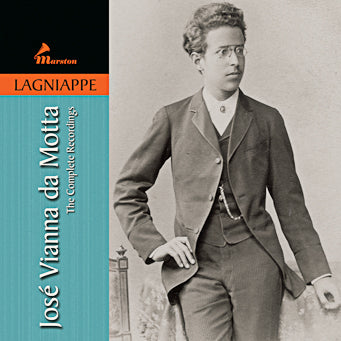José Vianna da Motta:
The Complete Recordings



| Total time: [52:18] | ||
Pathé Art Label |
||
Paris, 1928 |
||
| 1. | Menuetto from Sonata, Op. 78 (D. 894) (Schubert) | 3:12 |
| (N 8736-1) X. 5454 | ||
| 2. | Wohin? from Die schöne Müllerin (Schubert-Liszt) | 2:57 |
| (N 8737-1) X. 5454 | ||
| 3. | Polonaise in A-flat, Op. 53 (Chopin) | 6:15 |
| (N 8731-2 and 8732-1) X. 5452 | ||
| 4. | Turandots Frauengemach: Intermezzo (Elegy No. 4) (Busoni) | 3:29 |
| (N 8730-1) X. 5451 | ||
| 5. | Duettino Concertante for Two Pianos (After Mozart, Piano Concerto No. 19, K. 459: Finale) (Busoni) | 6:10 |
| with Mlle Castello Lopes (N 8738-2 and 8739-2) X. 5453 |
||
| 6. | Cantiga de Amor, Op. 9, No. 1 (Vianna da Motta) | 5:45 |
| (N 8725-1 and 8726-1) X. 5449 | ||
| 7. | Chula, Op. 9, No. 2 (Vianna da Motta) | 2:48 |
| (N 8727-1) X. 5450 | ||
| 8. | Valsa Caprichosa, Op. 9, No. 3 (Vianna da Motta) | 2:48 |
| (N 8728-2) X. 5450 | ||
| 9. | Églogue, S. 160, No. 7, from Années de Pèlerinage: Suisse (Liszt) | 3:04 |
| (N 8729-2) X. 5451 | ||
| 10. | Totentanz, S. 126 (Liszt) | 15:53 |
| Recorded live, 19 January 1945 Portuguese National Symphony Orchestra Pedro de Freitas Branco, conductor |
||
Producer: Ward Marston
Audio Conservaton: Ward Marston
Audio Assistance: J. Richard Harris, Andrew Rose, and Aaron Z Snyder
Booklet Notes: Donald Manildi
Photographs: Gregor Benko / Booklet Design: Takeshi Takahashi
José Vianna da Motta (1868-1948) was the last surviving pupil of Franz Liszt. Born on the Isle of St. Thomas in Portuguese Africa, his early music studies took place in Lisbon, after which he settled in Berlin to work for several years with both Xaver and Philipp Scharwenka. In 1885 he travelled to Weimar to attend Liszt’s master classes, and after Liszt’s death in 1886 he had some lessons from Hans von Bülow. By then his reputation as an exceptional virtuoso was well established. In the early 1900s he sought advice from Ferruccio Busoni, with whom he later collaborated in preparing the first collected edition of Liszt’s piano works.
Vianna da Motta’s performing career took him to most of Europe and to Russia, the United States, and South America. The outbreak of World War I found him in temporary exile in Geneva, where he directed the local conservatory for several years. He returned to his native Portugal in 1919 and remained there until his death, much sought-after as both soloist and as teacher at the Lisbon Conservatory. Perhaps his most significant pupil was Sequeira Costa, who taught in the US for many years and founded a piano competition in Lisbon named after his mentor.
Vianna da Motta’s concert activity included collaborations with Ysaÿe and Sarasate as well as at least one complete cycle of the Beethoven sonatas. His repertoire was extensive and it included several then-obscure composers like Alkan. He was equally busy as a composer; his output includes not only many piano works but also orchestral pieces and a string quartet.
In 1928 Vianna da Motta recorded the selections for Pathé reissued herewith. These represent the entirety of his sonic legacy, with the fortunate exception of Liszt’s Totentanz, captured live at a 1945 concert.
© Donald Manildi, 2013